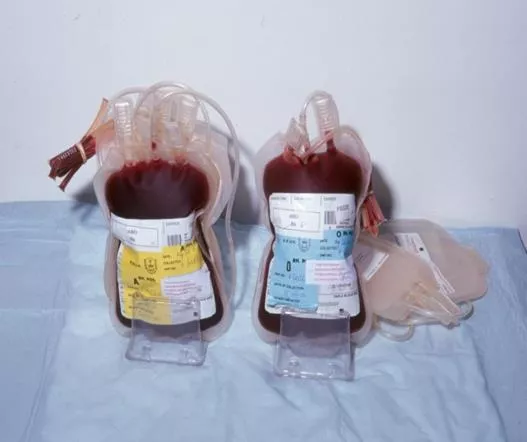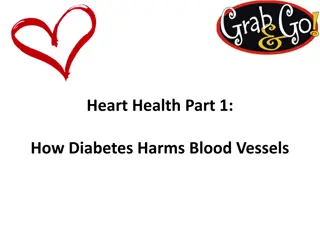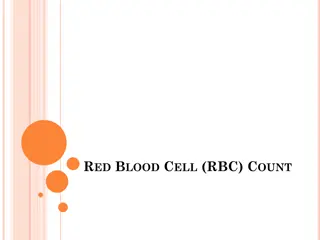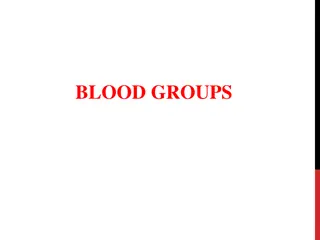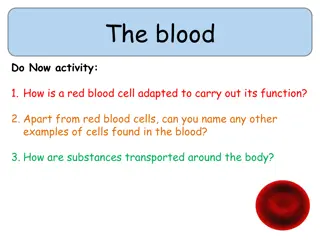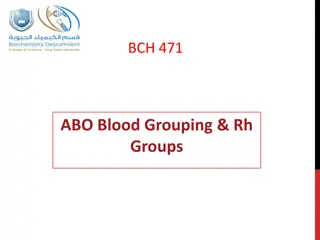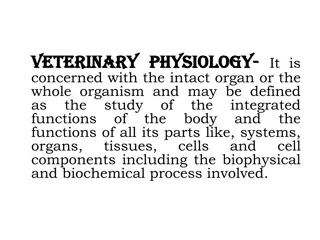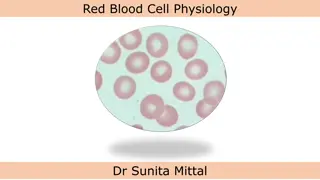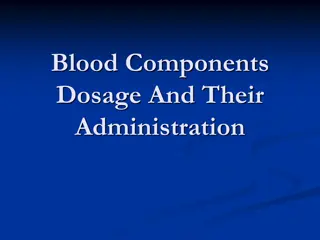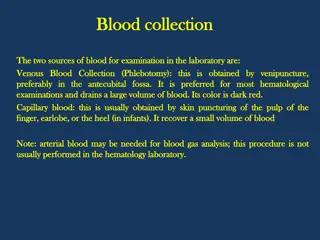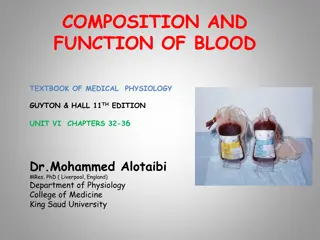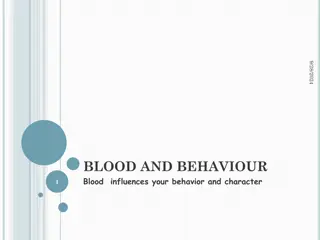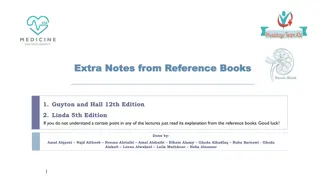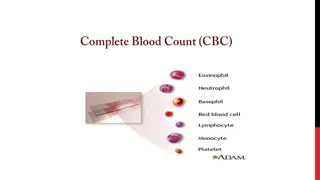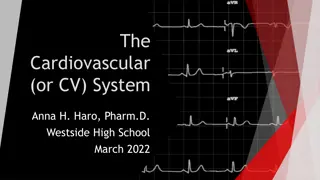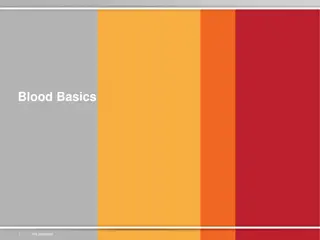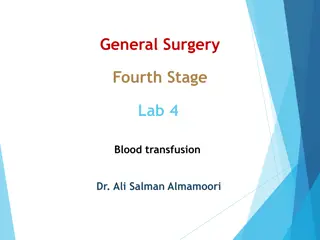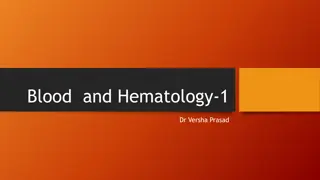Composition and Function of Blood in Medical Physiology Textbook
Blood, a vital fluid tissue in the cardiovascular system, plays essential roles in transportation, regulation, and protection within the body. This includes carrying gases, nutrients, hormones, and waste products, regulating temperature, pH, electrolytes, and blood pressure, as well as providing defense mechanisms and clotting functions. Comprised of cellular and non-cellular components, blood serves as a crucial medium for maintaining homeostasis in the body.
Download Presentation

Please find below an Image/Link to download the presentation.
The content on the website is provided AS IS for your information and personal use only. It may not be sold, licensed, or shared on other websites without obtaining consent from the author. Download presentation by click this link. If you encounter any issues during the download, it is possible that the publisher has removed the file from their server.
E N D
Presentation Transcript
COMPOSITION AND FUNCTION OF BLOOD TEXTBOOK OF MEDICAL PHYSIOLOGY GUYTON & HALL 11THEDITION UNIT VI CHAPTERS 32-36 Dr.Salah Elmalik Department of Physiology College of Medicine King Saud University 1
Objectives At the end of this lecture student should be able to: 1. Recognize functions of blood 2. Describe Cellular and non-cellular components of blood 3. Define Erythropoiesis; leukopoiesis, and thrombopoiesis. 4. Describe features of RBCs, WBCs, and Platelets.
What is Blood? Blood is a fluid connective tissue found within the cardiovascular system accounts for about 8% of TBW Its volume is 5-6 L in males and 4-5 L in females Much more dense than pure water It is slightly alkaline, with a pH of 7.35- 7.45 Its color varies from bright to dark red It has a salty metallic taste
General Function of the Blood 1- Transportation: A) Gases: O2 , CO2 , .. B) Nutrient and metabolic Wastes: Glucose, amino acids, . C) Hormones and Enzymes D) Antibodies E) Electrolytes and Ions
General Function of the Blood Cont. 2- Regulation: A) Temperature regulation B) pH regulation: By buffering systems found in the blood that maintain the pH between 7.35 to 7.45 C) Electrolytes regulation (Na, K, Cl, ..) D) Blood pressure regulation: by increasing or decreasing blood flow to the kidneys
General Function of the Blood Cont. 3- Protection: A) Defense mechanism: By white blood cells B) Clotting mechanism: Blood contains materials that stop bleeding when vessels are damaged (Hemostasis)
Composition of blood Blood consists of formed elements that are suspended and carried in a fluid called plasma
Blood Film http://blog.healthtap.com/images/shutterstock_77888173.jpg Formed Elements
55 % 45 %
Normal, High, and Low Hematocrit Levels 65 % 45 % 15 % Normal Anemia Polycythemia Hematocrit: is the percentage of blood volume occupied by red blood cells (RBCs)
55 % 45 %
Plasma Straw colored fluid made of water (~92%), other contents include: Proteins make the bulk of the solutes: manufactured in the liver - Albumins (60%), are the most abundant type of plasma proteins, maintain the plasma volume by osmotic pressure. ( No edema). - Globulins (35%), alpha and beta Globulins transport lipids and certain minerals through the bloodstream. Gamma Globulins are antibodies. - Fibrinogen (4%) for blood clotting
Plasma, cont. Nutrients: glucose, amino acids, lipids, cholesterol Electrolytes: Na+, K+, Ca++, Mg++, H+, Cl-, HCO3-, PO4--, SO4-- Waste: urea, creatinine, uric acid, bilirubin Gases: O2 , CO2 Protein bound hormones Plasma without clotting factors is called serum
BLOOD COMPOSITION 1. Cellular components Red Blood Cells, RBCs (Erythrocytes) White Blood Cells ,WBCs (Leukocytes) Platelets (Thrombocytes) 2. Plasma 92% water, ions, plasma proteins (Albumin, globulin, Fibrinogen) Same ionic composition as interstitial fluid 15
Blood Volume 5 liter in adult 45% is packed cells volume (PCV) 55% is plasma volume 16
Blood Cells Each type of blood cell performs a different function Red blood cells (Erythrocytes) White blood cells (Leukocytes) Platelets (Thrombocytes)
Hematopoiesis Is a formation of blood cells from stem cells in the red bone marrow (myeloid stem cell) & lymphatic tissue (lymphoid stem cell) Erythropoiesis is formation of RBCs Stimulated by erythropoietin (EPO) from kidney Leukopoiesis is formation of WBCs Stimulated by variety of cytokines Thrombopoiesis is formation of platelets
Red Blood Cells Function O2 transport CO2 transport Buffer http://images.iop.org/objects/phw/news/15/6/7/red-blood-cells.jpg 19
Red Blood Cells (Erythrocytes) Shape & size Flattened Biconcave Disc Lack nuclei and mitochondria Diameter 7-8 m Flexible Life span- 120 days Number =4.7-5.2 million/ mm3 20
White Blood Cells (Leukocytes) Shape & size Have nucleus and mitochondria Two types: granular and non-granular, Amoeboid Diapedesis - can "slip between" capillary wall Number =4,000-11,000 / mm3 http://www.sciencequiz.net/jcscience/jcbiology/circulatorysystem/white_blood_cells.jpg
Platelets (Thrombocytes) Shape & size Are smallest of formed elements. Lack nucleus Irregularly shaped fragments of megakaryocytes, amoeboid. Diameter: 2-3 m Life span- from 5 to 10 days Essential for clotting Number =250,000- 500,000/ mm3 http://www.ouhsc.edu/platelets/platelets/Platelet%20Pics/Platelets%201.gif
What we have learnt today? What we have learnt today?
Objectives At the end of this lecture student should be able to: 1. Recognize functions of blood 2. Describe Cellular and non-cellular components of blood 3. Define Erythropoiesis; leukopoiesis, and thrombopoiesis. 4. Describe features of RBCs, WBCs, and Platelets.


